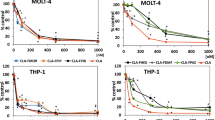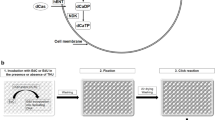Abstract
Purpose
Cytotoxicity from the anticancer drug 2′,2′-difluoro-2′-deoxycytidine (dFdCyd) has been correlated with its incorporation into DNA. However, cytotoxicity may also result from inhibition of DNA synthesis, due to either (1) dFdCyd diphosphate-mediated inhibition of ribonucleotide reductase, or (2) direct inhibition of DNA polymerases by the 5′-triphosphate of dFdCyd (dFdCTP). To elucidate the role of DNA synthesis inhibition in the cytotoxicity of dFdCyd, we compared dFdCyd to hydroxyurea (HU), a ribonucleotide reductase inhibitor, and aphidicolin, an inhibitor of DNA polymerases, in the U251 and D54 human glioblastoma cell lines.
Methods
Sensitivity to dFdCyd, HU, and aphidicolin were determined using a colony formation assay. The effects of these drugs on DNA synthesis were measured by dual parameter flow cytometry, while the effects on nucleotide pool levels were analyzed by high-performance liquid chromatography.
Results
HU and aphidicolin elicited substantially less cytotoxicity than the multi-log killing with dFdCyd. When used at equitoxic concentrations (24-h IC50 values), dFdCyd and HU decreased purine dNTP pools primarily, but dFdCyd was less effective than HU. dFdCyd had decreased dATP by about 80% after 4–12 h, and required 8–24 h to decrease DNA synthesis by 50%. In contrast, HU rapidly depleted dATP by >98% within 2 h, which resulted in >90% inhibition of DNA synthesis. Aphidicolin at a concentration similar to its Ki values for DNA polymerases (1 μM) decreased DNA synthesis by >70% within 2 h. However, this decreased cell survival by only 10% (U251 cells) and 40% (D54 cells).
Conclusions
These results demonstrate that HU and aphidicolin produced a more rapid and profound inhibition of DNA synthesis than dFdCyd, but resulted in significantly less cytotoxicity. This suggests that inhibition of DNA synthesis accounted for less than one log of the multi-log cytotoxicity observed with dFdCyd, whereas incorporation of dFdCTP into DNA is a more lethal event.



Similar content being viewed by others
References
Ahluwalia GS, Grem JL, Hao Z, Cooney DA (1990) Metabolism and action of amino acid analog anti-cancer agents. Pharmacol Ther 46:243
Baker CH, Banzon J, Bollinger JM, Stubbe J, Samano V, Robins MJ, Lippert B, Jarvi E, Resvick R (1991) 2′-Deoxy-2′-methylenecytidine and 2′-deoxy-2′,2′-difluorocytidine 5′-diphosphates: potent mechanism-based inhibitors of ribonucleotide reductase. J Med Chem 34:1879
Bianchi V, Pontis E, Reichard P (1986) Changes in deoxyribonucleoside triphosphate pools induced by hydroxyurea and their relation to DNA synthesis. J Biol Chem 261:16037
Bitonti AJ, Dumont JA, Bush TL, Cashman EA, Cross-Doersen DE, Wright PS, Matthews DP, McCarthy JR, Kaplan DA (1994) Regression of human breast tumor xenografts in response to (E)-2′-deoxy-2′-(fluoromethylene)cytidine, and inhibitor of ribonucleoside diphosphate reductase. Cancer Res 54:1485
Carson DA, Wasson DB, Kaye J, Ullman B, Martin DW, Robins RK, Montgomery JA (1980) Deoxycytidine kinase-mediated toxicity of deoxyadenosine analogs toward malignant human lymphoblasts in vitro and toward murine L1210 leukemia in vivo. Proc Natl Acad Sci U S A 77:6865
Chang C-H, Cheng Y (1980) Effects of deoxyadenosine triphosphate and 9-β-D-arabinofuranosyladenine 5′-triphosphate on human ribonucleotide reductase from Molt-4F cells and the concept of "self-potentiation". Cancer Res 40:3555
Eriksson S, Skog S, Tribukait B, Wallstrom B (1987) Deoxyribonucleoside triphosphate metabolism and the mammalian cell cycle. Exp Cell Res 168:79
Fox G, Popanda O, Edler L, Thielmann HW (1996) Preferential inhibition of DNA polymerases α, β, and ε from Novikoff hepatoma cells by inhibitors of cell proliferation. J Cancer Res Clinical Oncol 122:78
Fox RM (1985) Changes in deoxynucleoside triphosphate pools induced by inhibitors and modulators of ribonucleotide reductase. Pharmacol Ther 30:31
Fridland A (1977) Inhibition of deoxyribonucleic acid chain initiation: a new mode of action for 1-β-D-arabinofuranosylcytosine in human lymphoblasts. Biochemistry 16:5308
Gandhi V, Plunkett W, Kantarjian H, Talpaz M, Robertson LE, O'Brien S (1998) Cellular pharmacodynamics and plasma pharmacokinetics of parenterally infused hydroxyurea during a phase I clinical trial in chronic myelogenous leukemia. J Clin Oncol 16:2321
Goldman ID, Matherly LH (1985) The cellular pharmacology of methotrexate. Pharmacol Ther 28:77
Gregoire V, Van NT, Stephens C, Brock WA, Milas L, Plunkett W, Hittelman WN (1994) The role of fludarabine-induced apoptosis and cell cycle synchronization in enhanced murine tumor radiation response in vivo. Cancer Res 54:6201
Griffig J, Koob R, Blakely WF (1989) Mechanisms of inhibition of DNA synthesis by 2-chlorodeoxyadenosine in human lymphoblastic cells. Cancer Res 49:6923
Heinemann V, Hertel LW, Grindey GB, Plunkett W (1988) Comparison of the cellular pharmacokinetics and toxicity of 2′,2′-difluorodeoxycytidine and 1-β-D-arabinofuranosylcytosine. Cancer Res 48:4024
Heinemann V, Xu Y-Z, Chubb S, Sen A, Hertel LW, Grindey GB, Plunkett W (1990) Inhibition of ribonucleotide reduction in CCRF-CEM cells by 2′,2′-difluorodeoxycytidine. Mol Pharmacol 38:567
Heinemann V, Xu Y-Z, Chubb S, Sen A, Hertel LW, Grindey GB, Plunkett W (1992) Cellular elimination of 2′,2′-difluorodeoxycytidine 5′-triphosphate: a mechanism of self-potentiation. Cancer Res 52:533
Hendricks SP, Mathews CK (1998) Differential effects of hydroxyurea upon deoxyribonucleoside triphosphate pools, analyzed with vaccinia virus ribonucleotide reductase. J Biol Chem 273:29519
Hoglund L, Pontis E, Reichard P (1991) Deoxyribonucleotide metabolism in hydroxyurea-resistant V79 hamster cells. Eur J Biochem 196:239
Huang P, Siciliano MJ, Plunkett W (1989) Gene deletion, a mechanism of induced mutation by arabinosyl nucleosides. Mutat Res 210:291
Huang P, Chubb S, Hertel LW, Grindey GB, Plunkett W (1991) Action of 2′,2′-difluorodeoxycytidine on DNA synthesis. Cancer Res 51:6110
Jordan A, Reichard P (1998) Ribonucleotide reductases. Annu Rev Biochem 67:71
Kufe DW, Major PP, Egan EM, Beardsley GP (1980) Correlation of cytotoxicity with incorporation of ara-C into DNA. J Biol Chem 255:8997
Lagergren J, Reichard P (1987) Purine deoxyribonucleosides counteract effects of hydroxyurea on deoxyribonucleoside triphosphate pools and DNA synthesis. Biochem Pharmacol 36:2985
Lawrence TS, Chang EY, Hahn TM, Hertel LW, Shewach DS (1996) Radiosensitization of pancreatic cancer cells by 2′,2′-difluoro-2′-deoxycytidine. Int J Radiat Oncol Biol Phys 34:867
Matsukage A, Ono K, Ohashi A, Takahashi T, Nakayama C, Saneyoshi M (1978) Inhibitory effect of 1-β-D-arabinofuranosylthymine 5′-triphosphate and 1-β-D-arabinofuranosylcytosine 5′-triphosphate on DNA polymerases from murine cells and oncornavirus. Cancer Res 38:3076
Milas L, Fujii T, Hunter N, Elshaikh M, Mason KA, Plunkett W, Ang KK, Hittelman W (1999) Enhancement of tumor radioresponse in vivo by gemcitabine. Cancer Res 59:104
Moore EC, Cohen SS (1967) Effects of arabinonucleotides on ribonucleotide reduction by an enzyme system from rat tumor. J Biol Chem 212:2116
Nocentini G (1996) Ribonucleotide reductase inhibitors: new strategies for cancer chemotherapy. Crit Rev Oncol Hematol 22:89
Ostruszka LJ, Shewach DS (2000) Role of ribonucleotide reductase inhibition in cytotoxicity of gemcitabine (dFdCyd) (abstract). Proc Am Assoc Cancer Res 41:862
Ostruszka LJ, Shewach DS (2000) The role of cell cycle progression in radiosensitization by 2′,2′-difluoro-2′-deoxycytidine. Cancer Res 60:6080
Parker WB, Bapat AR, Shen J-X, Townsend AJ, Cheng Y (1988) Interaction of 2-halogenated dATP analogs (F, Cl, and Br) with human DNA polymerases, DNA primase, and ribonucleotide reductase. Mol Pharmacol 34:485
Parker WB, Shaddix SC, Chang CH, White LE, Rose LM, Brockman RW, Shortnacy AT, Montgomery JA, Secrist JA III, Bennett LL (1991) Effects of 2-chloro-9-(2-deoxy-2-fluoro-β-D-arabinofuranosyl)adenine on K562 cellular metabolism and the inhibition of human ribonucleotide reductase and DNA polymerases by its 5′-triphosphate. Cancer Res 51:2386
Parker WB, Shaddix SC, Rose LM, Shewach DS, Hertel L, Secrist JA III, Montgomery JA, Bennett LL (1999) Comparison of the mechanism of cytotoxicity of 2-chloro-9-(2-deoxy-2-fluoro-β-D-arabinofuranosyl)adenine, 2-chloro-9-(2-deoxy-2-fluoro-β-D-ribofuranosyl)adenine, and 2-chloro-9-(2-deoxy-2,2-difluoro-β -D-ribofuranosyl)adenine in CEM cells. Mol Pharmacol 55:515
Plunkett W, Saunders PP (1991) Metabolism and action of purine nucleoside analogs. Pharmacol Ther 49:239
Plunkett W, Huang P, Searcy CE, Gandhi V (1996) Gemcitabine: preclinical pharmacology and mechanisms of action. Semin Oncol 23:3
Prusoff W, Goz B (1975) Halogenated pyrimidine deoxyribonucleosides. In: Sartorelli AC, Johns DG (eds) Handbook of experimental pharmacology. Springer-Verlag, New York, pp. 272–347
Reid R, Mar E-C, Huang E-S, Topal MD (1988) Insertion and extension of acyclic, dideoxy, and ara nucleotides by herpesviridae, human α and human β polymerases. J Biol Chem 263:3898
Rockwell S, Grindey GB (1992) Effect of 2′,2′-difluorodeoxycytidine on the viability and radiosensitivity of EMT6 cells in vitro. Oncol Res 4:151
Ross DD, Cuddy DP (1994) Molecular effects of 2′,2′-difluorodeoxycytidine (gemcitabine) on DNA replication in intact HL-60 cells. Biochem Pharmacol 48:1619
Ruiz van Haperen VWT, Veerman G, Vermorken JB, Peters GJ (1993) 2′,2′-Difluoro-deoxycytidine (gemcitabine) incorporation into RNA and DNA of tumour cell lines. Biochem Pharmacol 46:762
Schy WE, Hertel LW, Kroin JS, Bloom LB, Goodman MF, Richardson FC (1993) Effect of a template-located 2′,2′-difluorodeoxycytidine on the kinetics and fidelity of base insertion by Klenow (3′-5′ exonuclease-) fragment. Cancer Res 53:4582
Sheaff R, Ilsley D, Kuchta R (1991) Mechanism of DNA polymerase α inhibition by aphidicolin. Biochemistry 30:8590
Shewach DS (1992) Quantitation of deoxyribonucleoside 5′-triphosphates by a sequential boronate and anion-exchange high pressure liquid chromatography procedure. Anal Biochem 206:178
Shewach DS, Ellero J, Mancini WR, Ensminger WD (1992) Decrease in TTP pools mediated by 5-bromo-2′-deoxyuridine exposure in a human glioblastoma cell line. Biochem Pharmacol 43:1579
Shewach DS, Hahn TM, Chang E, Hertel LW, Lawrence TS (1994) Metabolism of 2′,2′-difluoro-2′-deoxycytidine and radiation sensitization of human colon carcinoma cells. Cancer Res 54:3218
Sinclair WK (1968) The combined effect of hydroxyurea and x-rays on Chinese hamster cells in vitro. Cancer Res 28:198
Sun L-Q, Li Y-X, Guillou L, Coucke PA (1998) (E)-2′-Deoxy-2′-(fluoromethylene) cytidine potentiates radioresponse of two human solid tumor xenografts. Cancer Res 58:5411
Szybalski W (1974) X-ray sensitization by halopyrimidines. Cancer Chemother Rep 58:539
Tseng WC, Derse D, Cheng Y, Brockman RW, Bennett LL (1982) In vitro biological activity of 9-β-D-arabinofuranosyl-2-fluoroadenine and the biochemical actions of its triphosphate on DNA polymerases and ribonucleotide reductase from HeLa cells. Mol Pharmacol 21:474
Xie C, Plunkett W (1995) Metabolism and actions of 2-chloro-9-(2-deoxy-2-fluoro-β-D-arabinofuranosyl)-adenine in human lymphoblastoid cells. Cancer Res 55:2847
Acknowledgements
This work was supported in part by grant CA 83081 from the NIH/NCI, the University of Michigan Comprehensive Cancer Center NIH grant CA 46592, the University of Michigan Multipurpose Arthritis Center NIH AR20557, and the University of Michigan Core Flow Cytometry Facility.
Author information
Authors and Affiliations
Corresponding author
Rights and permissions
About this article
Cite this article
Ostruszka, L.J., Shewach, D.S. The role of DNA synthesis inhibition in the cytotoxicity of 2′,2′-difluoro-2′-deoxycytidine. Cancer Chemother Pharmacol 52, 325–332 (2003). https://doi.org/10.1007/s00280-003-0661-5
Received:
Accepted:
Published:
Issue Date:
DOI: https://doi.org/10.1007/s00280-003-0661-5




